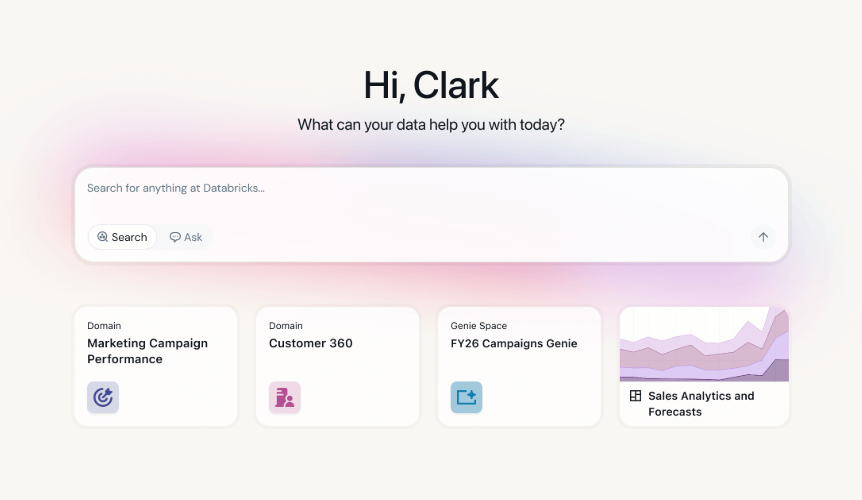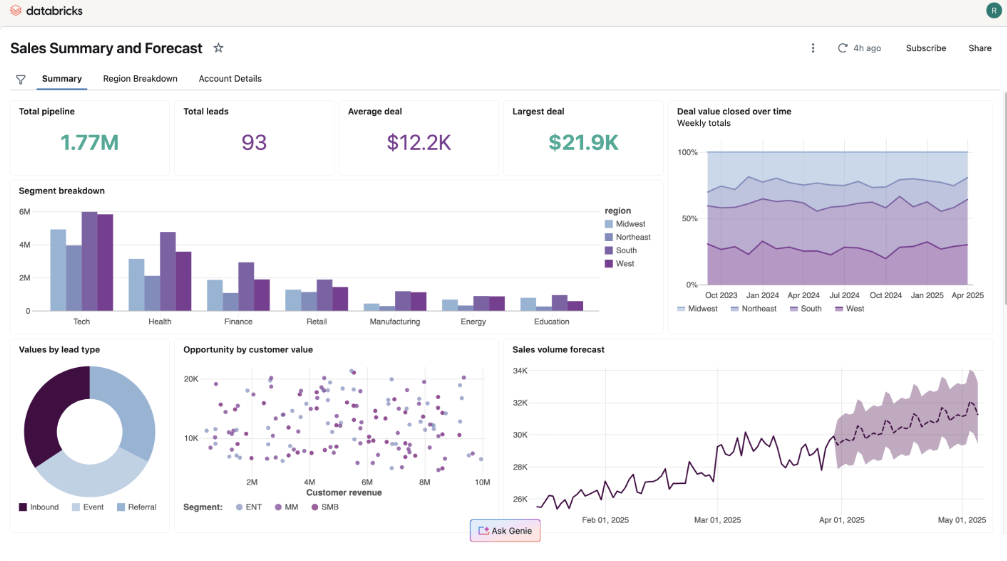 BIG DATA
BIG DATA
 BIG DATA
BIG DATA
 BIG DATA
BIG DATA
Databricks Inc. says it’s trying to bring the power of big data analytics to every business worker with the launch of its new artificial intelligence-powered business intelligence tool, Databricks One.
The company sells a cloud-based data warehouse platform that provides a collaborative environment for data engineering, data science, machine learning and analytics. It has become especially popular with companies who need to harness the power of their data for artificial intelligence. But until now, it has been limited to engineers and data scientists who possess the requisite Python and Structured Query Language skills.
Databricks One changes that, introducing a simplified user interface that makes the platform’s capabilities accessible to every kind of business worker.
“Our mission at Databricks is to democratize data and AI,” said Databricks co-founder and Chief Executive Ali Ghodsi. “Every person of every skill level should have equal access to work with data and use AI. With Databricks One, we want to make our experience for non-technical users as amazing as our experience for technical users.”
The company announced Databricks One today at its annual Data+AI Summit today in San Francisco, saying it’s available now in private preview ahead of a private beta slated for later in the summer. Though it’s currently free to use, the company intends to implement a metered pricing model based on token consumption by AI models and usage time.
It’ll do that because the entire platform is powered by generative AI models. The interface looks much like ChatGPT and other generative AI assistants, and allows users to describe the type of data analysis they want to perform. Then, a large language model performs the necessary technical work to get that analysis done. It can take actions such as deploying AI agents into data pipelines and databases to perform extremely specific and detailed analysis, the company said.
Before Databricks One, users would need coding skills to be able to make these kinds of requests, but the LLM eliminates the need for that. It generates the required SQL code itself, and executes it on the customer’s data warehouse, abstracting the complexity away from the user.
Once the analysis is done, Databricks One will show the results via suitable visualizations that appear directly in its interface. Users can then dig into these visualizations with an “AI/BI Genie,” and ask more detailed questions using natural language.

The use cases are varied. For instance, marketing professionals might want to perform some analytics to see how effective their latest campaign has been, while legal professionals might want to review any overlapping business contracts that could conflict with one another. Salespeople could use it to gather every piece of information they need ahead of a meeting with a new lead.
In an interview with Fast Company, Ghodsi said customers have been asking for years for these kinds of AI-powered business intelligence capabilities. They want their regular business workers to be able to perform the same deep analytics that their engineers already do, because it would allow them to act on the insights they dig up much faster. However, many customers – especially those in regulated industries such as finance and healthcare – also highlighted concerns about data security and the prospect that business workers might misinterpret the findings from their data.
That’s why it took so long for Databricks to build the Databricks One platform, Ghodsi said. The company spent more than two years designing guardrails to ensure the security of customer data. These guardrails make sure the most sensitive data is sandboxed, and users can be restricted to read-only access, he said.
Databricks One was launched on a hectic day for the company, which also debuted a new agentic AI platform called Mosaic Agent Bricks. It provides tools for automating AI agent building and customizing them using customer’s private data and synthetic information based on those archives.
In addition, the company announced a new serverless database called Lakebase, based on the popular open-source relational database software PostgreSQL. It can process more than 10,000 queries per second to power demanding AI workloads.
Today’s updates illustrate Databricks’ determination to capitalize on the demand for AI applications and become the main provider of the data that powers them. Investors have backed the company heavily, with venture capitalists putting more than $14 billion into its war chest, boosting its value to an astonishing $62 billion as of December 2024.
Support our mission to keep content open and free by engaging with theCUBE community. Join theCUBE’s Alumni Trust Network, where technology leaders connect, share intelligence and create opportunities.
Founded by tech visionaries John Furrier and Dave Vellante, SiliconANGLE Media has built a dynamic ecosystem of industry-leading digital media brands that reach 15+ million elite tech professionals. Our new proprietary theCUBE AI Video Cloud is breaking ground in audience interaction, leveraging theCUBEai.com neural network to help technology companies make data-driven decisions and stay at the forefront of industry conversations.